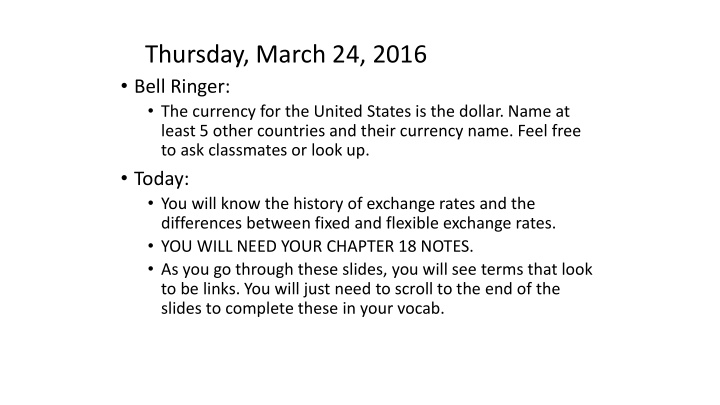



Thursday, March 24, 2016 • Bell Ringer: • The currency for the United States is the dollar. Name at least 5 other countries and their currency name. Feel free to ask classmates or look up. • Today: • You will know the history of exchange rates and the differences between fixed and flexible exchange rates. • YOU WILL NEED YOUR CHAPTER 18 NOTES. • As you go through these slides, you will see terms that look to be links. You will just need to scroll to the end of the slides to complete these in your vocab.
Fixed Exchange Rates Under a system of fixed exchange rates, national governments set the value of their currencies relative to other currencies.
Fixed Exchange Rates (cont.) • Countries must find a common way to pay one another for the goods they import and export. The exchange rate becomes a key factor. • Foreign exchange markets allow for individuals and businesses to easily and quickly convert one currency to another. • From 1945 to 1970s, they operated with a fixed rate of exchange . View: Foreign Exchange Rate Listing
Fixed Exchange Rates (cont.) • The International Monetary Fund (IMF) supported a fixed rate of exchange. • A fixed rate of exchange had some advantages: – Importers and exporters knew exactly how much of a foreign currency they could purchase with their own nation’s money. – The system allowed central banks to affect the level of exports and imports in their country by devaluing the currency.
Fixed Exchange Rates (cont.) • Devaluation is the lowering a currency’s value in relation to other currencies by government order. • However, this system of a fixed rate of exchange proved impractical. View: Effects of Devaluation
Fixed exchange rates were impractical because of an international economic climate that was constantly changing due to inflation and other factors. A. True A. A B. False B. B C. C D. D 0% 0% 0% 0% A B C D
Flexible Exchange Rates Under a system of flexible exchange rates, supply and demand determine currency values.
Flexible Exchange Rates (cont.) • In August 1971 most of the world’s nations turned to a flexible exchange rate . • The forces actually determining exchange rates are the supply and demand of goods and services that can be bought with a particular currency. • In addition, political or economic instability within a country may encourage people to exchange their currency for a more stable currency.
Flexible Exchange Rates (cont.) • As with devaluation, depreciation of a country’s currency improves its competitive edge in foreign trade. Definition : Exchange rates allow you to determine how much of one currency you can exchange for another. For example, the dollar's exchange rate tells you how much a dollar is worth in a foreign currency, and vice versa. You will definitely need to understand exchange rates when you travel to another country. For example, if you traveled to Canada on September 30, 2013, you'd find a dollar was worth $1.03 Canadian dollars. Currency/International Trade/US Dollar video — please watch this. The link is available on my web site. X-change rates —we’ll look at this link next week.
• On August 11, 2015, China modified its policy to allow the yuan more flexibility. For more, see Yuan to Dollar Conversion. • Why the Euro is special?
Which type of exchange rate do you feel is best for the world economy? A. Fixed B. Flexible A. A B. B 0% 0% A B
Balance of Trade The United States has had a negative balance of trade since the 1970s.
Balance of Trade (cont.) • A currency’s exchange rate has an important effect on a nation’s balance of trade . – There is a positive balance of trade when the value of goods leaving a nation exceeds the value of those coming in. – When the value of goods coming into a country is greater than the value of those going out, there is a trade deficit. – Current balance of trade #s View: United States Balance of Trade
Vocab6 exchange rate: the price of one nation’s currency in terms of another nation’s currency
Vocab7 foreign exchange markets: markets dealing in buying and selling foreign currency for businesses that want to import goods from other countries
Vocab8 fixed rate of exchange: system under which a national government sets the value of its currency in relation to other currencies
Vocab9 International Monetary Fund (IMF): agency whose member governments once were obligated to keep their foreign exchange rates more or less fixed; today it offers monetary advice and provides loans to developing nations
Vocab10 devaluation: lowering a currency’s value in relation to other currencies by government order
Vocab11 flexible exchange rate: arrangement in which the forces of supply and demand are allowed to set the price of various currencies
Vocab12 depreciation: fall in the price of a currency through the action of supply and demand
Vocab13 balance of trade: difference between the value of a nation’s exports and its imports
Recommend
More recommend